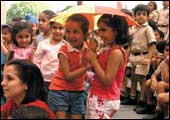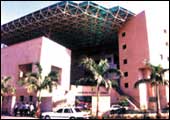|
|
|
SelaQui School, Dehradun:
Connected by long-range ethernet, students can log on from
anywhere in the school's 52-acre campus
|
|
|
Shruti
Ravi is in the sixth standard, but peek into her school satchel
and there's never an exercise book in there. Nor a workbook. Or
even a notebook. That's because Shruti never needs one. At school
every morning, she merely flips open the laptop computer on her
desk, checks the assignments that appear on her screen and then
gets down to business. On a typical day, she searches for a few
e-texts on the school's virtual network-yes, that's precisely why
she doesn't have to lug around fat tomes with her every day-and
even checks out a digitized video clip and surfs the net for all
the information she needs. Research over, Shruti completes her written
assignment and e-mails it back to her teacher.
Back home, Shruti's parents can go online to
check their daughter's grades, compare them with the previous ones
and also monitor her progress, while her teachers at school mark
and grade their students online. Welcome to a paperless classroom
at Mumbai's American School. Well, the school hasn't quite gone
totally paperless yet but is getting there. According to James Mains,
the school's superintendent, the transformation is being done in
phases and the senior school will be completely paperless by next
year. All students from Class VI through Class XII will have a laptop
to take notes, complete assignments, take tests and do research
and also get simultaneous feedback from their teachers. Gushes Harry
Berret, the American School's technology director, who has set up
a WI-FI (wireless fidelity) network for the school: "We are
not subscribing to an on-line curriculum source, not just making
equipment available to teachers and students, but rather we were
changing the way we approach education."
|
|
|
The
school has invested Rs 78 crore in its 150-acre campus
Jain International Residential School, Bangalore
|
They're not alone. Just next to the American
School is the upcoming Dhirubhai Ambani International School (dais),
whose students will be able to hook up desktops and laptops via
420 data points and learn in computer laboratories and a social
science laboratory, where technology will be the means for teaching
history and geography. At dais' library, 44 networked computers
will help students do research and browse reference texts.
Technology is it in the brave new world of schools.
Up north in Gurgaon, near Delhi, the new Pathways World School,
a Rs 100-crore project, is also a wireless school where it is compulsory
for all students to have laptops. At SelaQui, a residential school
in Dehradun, parents fork out Rs 1.57 lakh in annual fees but get
in return a package-wholesome education, extra-curricular activities
and discipline-all technology-enhanced, of course. SelaQui's technology
and networks are facilitated by Cisco Systems whose head of Indian
operations is also on the board of the school. The Gurukul Trust,
founders of SelaQui, will invest Rs 50 crore in the 52-acre campus
that began operations last year. For the record, the school, which
now has just 125 students, expects to breakeven in another two years.
 |
Wired from Day 1, the school is a
pioneer in tech-enabled education
Vasant Valley School, New Delhi |
Thousands of miles away from SelaQui is the
Jain International Residential School, whose Chairman, R. Chenraj
Jain (who, incidentally is a high-school dropout), has pumped in
Rs 78 crore in the 150-acre campus. Jain's school charges a hefty
Rs 2.5 lakh annually but there are 20 applicants for each of its
680 seats. At the Pathways World School, science labs are designed
for computer simulation of dangerous experiments and a well-equipped
library/media centre includes a distance-learning studio for access
to curriculum and teaching from some of the best universities in
the world. Fees are upwards of Rs 3 lakh but bookings are in full
swing.
But technology is just the means to an end.
Most of these new age schools emphasise new methods of learning.
Says Arun Kapur, Delhi's Vasant Valley School, which has been a
pioneer in this field: "The corporate world has always had
an arm in research and one in education. Now they are simply transferring
that new-found knowledge in terms of new education method.'' At
Vasant Valley, which was established in 1990, the emphasis is not
just computer-based education but both student and faculty development
through technology-enabled education.
 |
The school's wi-fi network is set
to take learning to the next level
American School, Mumbai |
The new breed of schools also splurges on creature
comforts. The Pathways World School is centrally airconditioned
and entirely covered with a fibreglass ceiling; it has a huge amphitheatre
as well as mini amphitheatres in each academic block for outdoor
classes; and its dorms are almost like five-star hotel rooms-spacious
with a bathroom for every two students-and pamperingly equipped
with luxuries like left-handed scissors for southpaws. At Bangalore's
Jain International, former national sportsmen like Ashish Balal
(hockey) and A.V. Jayaprakash (cricket) coach students in a Rs 25-crore
indoor stadium. Personal attention is another big USP of most of
these new age schools. No class size is bigger than 25 and teacher-student
ratios are often as good as 1:10 (Jain International School). With
special attention and an encouragement for extracurricular activities,
many students have already started making a mark. Last year, Neha
Nagpal, a student of Class IX at Jain International, released her
debut album Man Doley through BMG Crescendo. Neha's a budding Hindi-popper,
thanks, in part, to her music lessons in school. What more could
she (and her parents) ask for?
-additional reporting by Venkatesha
Babu & Debojyoti Chatterjee
|
TREADMILL
|
| What You Eat Is What You Are
 Anybody
who's serious about working out knows that breaking your meals
into four or five small ones, spread through the day, is better
than two or three big ones. That way your metabolic system
is active throughout the day and you assimilate food better.
Ditto for the importance of having breakfast. It kick-starts
your metabolism and you should heed the advice not to skip
it. But this time Treadmill will dwell on the Food Pyramid
and how that could explain what you should eat. Anybody
who's serious about working out knows that breaking your meals
into four or five small ones, spread through the day, is better
than two or three big ones. That way your metabolic system
is active throughout the day and you assimilate food better.
Ditto for the importance of having breakfast. It kick-starts
your metabolism and you should heed the advice not to skip
it. But this time Treadmill will dwell on the Food Pyramid
and how that could explain what you should eat.
The Food Guide Pyramid was developed by the US Department
of Agriculture. It places food into six groups and shows how
many servings from each you should eat. The six groups are:
a) Fats, oils and sweets. They are the pyramid's apex. Advise:
eat sparingly; b) Milk, yoghurt and cheese; Advise: eat two-to-three
servings (a serving of milk is a cupful and 30 grams of cheese);
c) Meat, poultry, fish, dried beans, eggs and nuts; Advice:
two-to-three servings (a serving means 50-80 grams of cooked
meat or fish, one egg, a cup of cooked beans or dal); d) Vegetables;
Advice: three-to-five servings (a serving is a cup of cooked
vegetables); e) Fruit; Advice: one serving (a piece of fruit
and a cup of juice); f) Bread, cereal, rice and pasta; Advice:
Six to 11 servings (one serving is a slice of bread, half
a cup of rice or pasta).
If you use the pyramid as a guide to plan what you eat,
you'll see the benefits. There's a catch. You have to exercise.
Start with a programme-it could be brisk walking or running
or resistance training-that's not exacting. Spend 20-30 minutes
three times a week working out. Exercise makes your heart
beat faster. How fast your heart has to beat depends on how
old you are and your general state of health. To find your
maximum heart rate, subtract your age from 220. If you're
healthy, aerobic exercise should increase your heart rate
to 60-80 per cent of the maximum. Multiply your maximum rate
by .06 to find 60 per cent and by .08 to find 80 per cent.
That's the number of times your heart should beat in one minute
during exercise.
As Treadmill has often observed, getting into or even getting
back to an exercise programme and sticking with it can be
painful-the temptations to dump the programme and get on with
your slothful life are just too overpowering. But there's
just one thing: if you adopt an exercise-diet combo, it just
has to show results. There now, motivated enough?
-MUSCLES MANI
|
|

